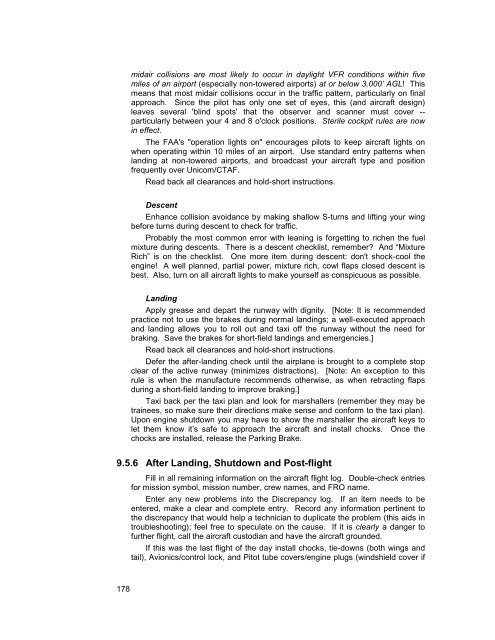MART Vol. II MO/MP - NESA - Civil Air Patrol
MART Vol. II MO/MP - NESA - Civil Air Patrol
MART Vol. II MO/MP - NESA - Civil Air Patrol
Create successful ePaper yourself
Turn your PDF publications into a flip-book with our unique Google optimized e-Paper software.
midair collisions are most likely to occur in daylight VFR conditions within fivemiles of an airport (especially non-towered airports) at or below 3,000’ AGL! Thismeans that most midair collisions occur in the traffic pattern, particularly on finalapproach. Since the pilot has only one set of eyes, this (and aircraft design)leaves several 'blind spots' that the observer and scanner must cover --particularly between your 4 and 8 o'clock positions. Sterile cockpit rules are nowin effect.The FAA's "operation lights on" encourages pilots to keep aircraft lights onwhen operating within 10 miles of an airport. Use standard entry patterns whenlanding at non-towered airports, and broadcast your aircraft type and positionfrequently over Unicom/CTAF.Read back all clearances and hold-short instructions.DescentEnhance collision avoidance by making shallow S-turns and lifting your wingbefore turns during descent to check for traffic.Probably the most common error with leaning is forgetting to richen the fuelmixture during descents. There is a descent checklist, remember? And “MixtureRich” is on the checklist. One more item during descent: don't shock-cool theengine! A well planned, partial power, mixture rich, cowl flaps closed descent isbest. Also, turn on all aircraft lights to make yourself as conspicuous as possible.LandingApply grease and depart the runway with dignity. [Note: It is recommendedpractice not to use the brakes during normal landings; a well-executed approachand landing allows you to roll out and taxi off the runway without the need forbraking. Save the brakes for short-field landings and emergencies.]Read back all clearances and hold-short instructions.Defer the after-landing check until the airplane is brought to a complete stopclear of the active runway (minimizes distractions). [Note: An exception to thisrule is when the manufacture recommends otherwise, as when retracting flapsduring a short-field landing to improve braking.]Taxi back per the taxi plan and look for marshallers (remember they may betrainees, so make sure their directions make sense and conform to the taxi plan).Upon engine shutdown you may have to show the marshaller the aircraft keys tolet them know it’s safe to approach the aircraft and install chocks. Once thechocks are installed, release the Parking Brake.9.5.6 After Landing, Shutdown and Post-flightFill in all remaining information on the aircraft flight log. Double-check entriesfor mission symbol, mission number, crew names, and FRO name.Enter any new problems into the Discrepancy log. If an item needs to beentered, make a clear and complete entry. Record any information pertinent tothe discrepancy that would help a technician to duplicate the problem (this aids introubleshooting); feel free to speculate on the cause. If it is clearly a danger tofurther flight, call the aircraft custodian and have the aircraft grounded.If this was the last flight of the day install chocks, tie-downs (both wings andtail), Avionics/control lock, and Pitot tube covers/engine plugs (windshield cover if178














